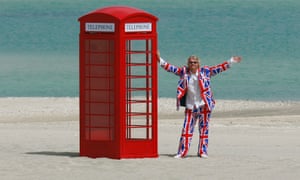Underwater bedrooms, ‘Lohan Island’ and snow all year round – a decade after it was scuppered by the financial crash, the fantasy archipelago of 300 artificial ‘countries’ is back in business. Has anybody learned anything?
by Oliver Wainwright in DubaiIhad the whole of Palestine to myself that day. It was only a short swim from Lebanon but, as I waded ashore out of the shallow, soupy water, it became clear that I was the only visitor the island had seen for some time. Clambering to the top of the hill, over a lunar landscape populated by the occasional piece of driftwood and the odd discarded beer bottle, I could see the sandy mounds of Jordan, Saudi Arabia and Ethiopia beyond, rising out of the sea like bobbing croutons. The gleaming spire of the Burj Khalifa twinkled through the haze on the distant horizon.
A decade since it was dredged from the seabed, The World is a forlorn sight. It was the most ambitious plan of Dubai’s pre-crash bubble, topping the creation of peninsulas shaped like palm trees and the construction of the tallest building on the planet, dreamed up as the ultimate trophy project to trump them all. In pursuit of the world’s attention, the oil-rich emirate would remake the world itself. “The Palm puts Dubai on the map,” proclaimed the marketing material at the time. “The World puts the map on Dubai.”
Conceived in 2003, the project was to be an exclusive offshore playground for film stars, royalty and celebrity tycoons: an artificial archipelago of 300 islands set two miles off the coast. Invitations to “Own the World” were sent to a targeted group of 50 potential buyers each year, offering tours of the site by yacht or helicopter, with prices for the islands ranging from $15-50m (£10-36m). Richard Branson posed for photos on little Britain in a Union Jack suit; Karl Lagerfeld launched plans for a fashion-themed island; rumours swirled that Brad Pitt and Angelina Jolie had acquired Ethiopia for their ever-expanding clan of adopted children.
After five years of dredging, which saw 320 million cubic metres of sand and 25 million tonnes of rock hauled into place, the final stone in the breakwater was laid in January 2008 – on the eve of the global financial crisis. The vision collapsed just as quickly as the computer renderings had been conjured. Dubai World, the government investment arm in charge of the project, was revealed to have debts of $60bn.
Surveying the barren spots of sand that dot the sea today – which, in aerial images, make it look as if the Gulf is suffering from a nasty case of acne – it’s hard to shake the sense of an Ozymandian ruin. Covering more than 5,000 hectares – almost seven times the size of Venice – and encircled by a 20-mile-long breakwater, the remains of The World lie as a mind-boggling monument to the spectacular hubris of a moment in time when anything seemed possible. The owners of Ireland were planning to rebuild the Giant’s Causeway, along with typical Irish streets, pubs and rolling green countryside. A Chinese billionaire had drawn up plans to remake Shanghai’s skyline on his island, complete with a copy of the Oriental Pearl TV Tower. A company called Opulence Holdings had acquired Somalia, with ambitions to sculpt it into the shape of a seahorse, where residents could hit golf balls from their balconies.
Overnight, billions of pounds in construction contracts evaporated in a puff of sand, leaving a trail of bankruptcies, lawsuits and unpaid debts. The owner of Great Britain, Safi Qurashi, was jailed, accused of bouncing £50m of cheques (for which he was later exonerated, after serving three years), and the owner of Ireland, John O’Dolan, killed himself in early 2009. After years of being hounded by irate investors wondering where their money had gone, the British co-owner of Thailand, Imtiaz Khoda, was recently jailed for an unrelated fraud, as part of a group that conned NHS hospitals, councils and a government out of more than £12m. Dogged by associations with shell companies and criminal dealings, the whole project became toxic, damned by rumours of money-laundering, pyramid schemes and reports that the islands were sinking into the sea.




Geen opmerkingen:
Een reactie posten